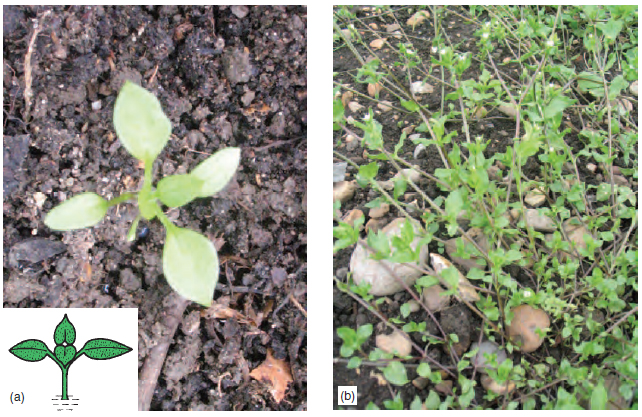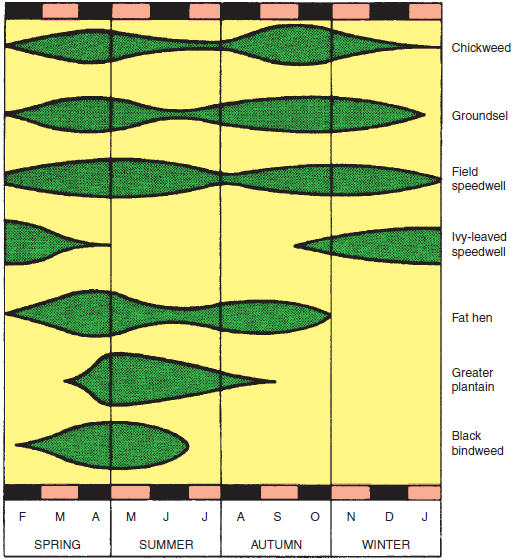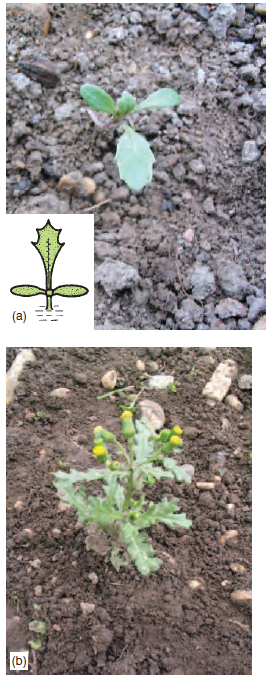Ephemeral weeds
Content
Chickweed (Stellaria media). Plant family – Caryophyllaceae Damage: This species is found in many horticultural situations as a weed of flowerbeds, vegetables, soft fruit and greenhouse plantings. It has a wide distribution throughout Britain, grows on land up to altitudes of 700 m, and is most important on rich, heavy soils. Life cycle: The seedling cotyledons are pointed with a light-coloured tip while its true leaves have hairy petioles (see Figure 13.5). The adult plant has a characteristic lush appearance and grows in a prostrate manner over the surface of the soil; in some cases it covers an area of 0.1 square metres, its leafy stems crowding out young plants as it increases in size. Small white, five-petalled flowers are produced throughout the year, the flowering response being indifferent to day length. The flowers are self-fertile.
An average of 2500 disc-like seeds (1 mm in diameter) may result from the oblong fruit capsules produced by one plant. Since the first seed may be dispersed within 6 weeks of the plant germinating and the plant continues to produce seed for several months, it can be seen just how prolific the species is. The large numbers of seed (up to 14 million/ha) are most commonly found in the top 7 cm of the soil where, under conditions of light, fluctuating temperatures and nitrate ions, they may overcome the dormancy mechanism and germinate to form the seedling. Many seeds, however, survive up to the second, third and occasionally fourth years. Figure 13.6 shows that germination can occur at any time of the year, with April and September as peak periods. Chickweed is an alternate host for many aphid transmitted viruses (e.g. cucumber mosaic), and the stem and bulb nematode.
Control: This weed is controlled by a combination of methods. Physical controls include partial sterilization of soil in greenhouses while hoeing in the spring and autumn periods prevents the seedling from developing and flowering. Mulching is effective against germinating weeds. Amateur gardeners can use the non-selective, non-persistent herbicide, glufosinate-ammonium plus fatty acids for control in such situations as ornamental beds containing woody perennials, and in cane fruit. professional horticulturalists use pre-emergent contact sprays such as paraquat applied before a crop emerges. A soil-applied root-acting herbicide such as propachlor is used on a crop such as strawberries before weeds germinate. A foliage-acting herbicide such as linuron is applied for chickweed control in potatoes. Groundsel (Senecio vulgaris). Plant family – Asteraceae (Compositae)
Life cycle: The seedling cotyledons are narrow, purple underneath, and the first true leaves have step-like teeth (see Figure 13.7). The adult plant has an upright habit, and produces as many as 25 yellow, small-petalled flower heads. Flowering occurs in all seasons of the year. Produces about 45 column-shaped seeds, 2 mm in length densely packed in the fruit head. As can be seen in Figure 13.5, the seeds may germinate at any time of the year, with early May and September as peak periods. Since there may be more than three generations of groundsel per year (the autumn generation surviving the winter), and each generation may give rise to a thousand seeds, it is clear why groundsel is one of the most successful colonizers of cultivated ground. Its role as a symptomless carrier of the wilt fungus, Verticillium , increases its importance in certain crops, e.g. tomatoes and hops. Spread: The seeds bear a mass of fine hairs. These hairs, in dry weather, can parachute seeds along on air currents for many metres. In wet weather the seeds become sticky and may be carried on the feet of animals, including humans. The seeds survive digestion by birds, and thus can be transported in this way. Control: A combination of control methods may be necessary for successful control. Physical control is by hoeing or by mechanical cultivation, particularly in spring and autumn to prevent developing seedlings from flowering. Care should be taken not to allow uprooted flowering groundsel plants to release viable seed. The amateur gardener can use the herbicide, glufosinateammonium plus fatty acids, for control in such situations as ornamental beds containing woody perennials, and in cane fruit. The professional horticulturalist can use contact herbicides, such as paraquat to control the weed in all stages of growth on paths or in fallow soil (but never on garden plants or turf). Soil-acting chemicals such as propachlor on brassicas kill off the germinating seedling. An established groundsel population, especially in a crop such as lettuce (a fellow member of the Asteraceae family) requires careful choice of herbicide to avoid damage to the crop (see also propyzamide). |
||||||||||||||||||||||||||||||







